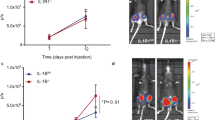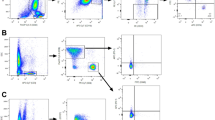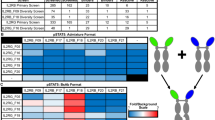Abstract
In a phase I trial the toxicity and immunomodulatory effects of combined treatment with intravenous (i.v.) bispecific monoclonal antibody BIS-1 and subcutaneous (s.c.) interleukin 2 (IL-2) was studied in renal cell cancer patients. BIS-1 combines a specificity against CD3 on T lymphocytes with a specificity against a 40 kDa pancarcinoma-associated antigen, EGP-2. Patients received BIS-1 F(ab')2 fragments intravenously at doses of 1, 3 and 5 micrograms kg-1 body weight during a concomitantly given standard s.c. IL-2 treatment. For each dose, four patients were treated with a 2 h BIS-1 infusion in the second and fourth week of IL-2 therapy. Acute BIS-1 F(ab')2-related toxicity with symptoms of chills, peripheral vasoconstriction and temporary dyspnoea was observed in 2/4 and 5/5 patients at the 3 and 5 micrograms kg-1 dose level respectively. The maximum tolerated dose (MTD) of BIS-1 F(ab')2 was 5 micrograms kg-1. Elevated plasma levels of tumour necrosis factor alpha (TNF-alpha) and interferon gamma (IFN-gamma) were detected at the MTD. Flow cytometric analysis showed a dose-dependent binding of BIS-1 F(ab')2 to circulating T lymphocytes. Peripheral blood mononuclear cells (PBMCs), isolated after treatment with 3 and 5 micrograms kg-1 BIS-1, showed increased specific cytolytic capacity against EGP-2+ tumour cells as tested in an ex vivo performed assay. Maximal killing capacity of the PBMCs, as assessed by adding excess BIS-1 to the assay, was shown to be decreased after BIS-1 infusion at 5 micrograms kg-1 BIS-1 F(ab')2. A BIS-1 F(ab')2 dose-dependent disappearance of circulating mononuclear cells from the peripheral blood was observed. Within the circulating CD3+ CD8+ lymphocyte population. LFA-1 alpha-bright and HLA-DR+ T-cell numbers decreased preferentially. It is concluded that i.v. BIS-1 F(ab')2, when combined with s.c. IL-2, has a MTD of 5 micrograms kg-1. The treatment endows the T lymphocytes with a specific anti-EGP-2-directed cytotoxic potential.
This is a preview of subscription content, access via your institution
Access options
Subscribe to this journal
Receive 24 print issues and online access
$259.00 per year
only $10.79 per issue
Buy this article
- Purchase on SpringerLink
- Instant access to full article PDF
Prices may be subject to local taxes which are calculated during checkout
Similar content being viewed by others
Author information
Authors and Affiliations
Rights and permissions
About this article
Cite this article
Kroesen, B., Buter, J., Sleijfer, D. et al. Phase I study of intravenously applied bispecific antibody in renal cell cancer patients receiving subcutaneous interleukin 2. Br J Cancer 70, 652–661 (1994). https://doi.org/10.1038/bjc.1994.366
Issue date:
DOI: https://doi.org/10.1038/bjc.1994.366
This article is cited by
-
Characterization of a Bispecific FLT3 X CD3 Antibody in an Improved, Recombinant Format for the Treatment of Leukemia
Molecular Therapy (2015)
-
Targeted cancer immunotherapy via combination of designer bispecific antibody and novel gene-engineered T cells
Journal of Translational Medicine (2014)
-
Bispecific Antibodies and Trispecific Immunocytokines for Targeting the Immune System Against Cancer
BioDrugs (2013)
-
CD3 × CD28 cross-interacting bispecific antibodies improve tumor cell dependent T-cell activation
Cancer Immunology, Immunotherapy (2005)
-
Activation of lymphocytes by anti-CD3 single-chain antibody dimers expressed on the plasma membrane of tumor cells
Gene Therapy (2000)



